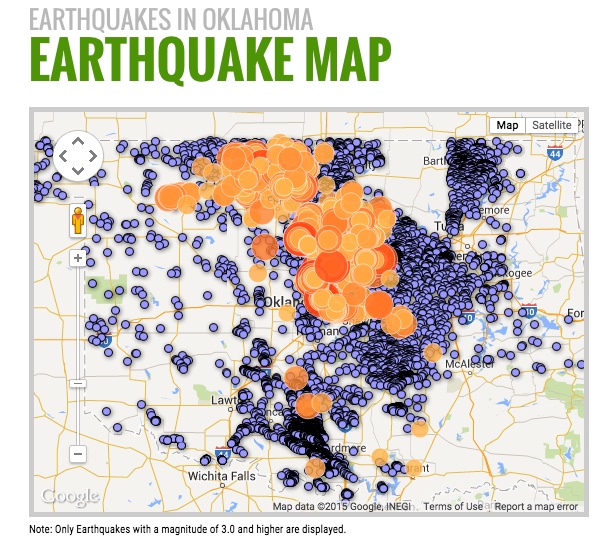
Image Credit: Earthquakes in Oklahoma
For years, Oklahoma officially didn’t connect the underground disposal of huge amounts of wastewater from oil and gas wells and a mushrooming number of earthquakes that caused millions of dollars in damages. That’s just changed.
The state’s energy and environment office has unveiled a new website cataloging the rising number of earthquakes and attributing a majority of them in central and north-central Oklahoma to the injection of wastewater into disposal wells.
“We know that Oklahoma experienced 109 magnitude 3+ earthquakes in 2013 and five times that amount in 2014,” the website says. “The pace of earthquake activity has accelerated this year. The current average rate of earthquakes is approximately 600 times historical averages.”
Although the state has “historically experienced some level of seismicity,” it adds, the Oklahoma Geological Survey now believes the rising number of temblors are not all due to natural causes but “very likely triggered by the injection of produced water in disposal wells.”
The website’s interactive map allows users to see where earthquakes have occurred in different time frames, and compare that data to the location of wastewater disposal wells. Most of the seismic activity has been in the area immediately north of Oklahoma City.
The Oklahoma Geological Survey thinks the “primary suspected source” of the earthquakes is not from hydraulic fracturing — the injection of water and sand into shale formations to unlock gas and oil reserves — but from the “subsequent disposal of produced water.”
A pattern seen elsewhere in the West
While Oklahoma has been the hardest hit state, it’s by no means the only one. The Los Angeles Times reported April 23 the U.S. Geological Survey has now published a map showing the proximity of earthquakes in four other states to “deep fluid injection wells or other industrial activities capable of inducing earthquakes.”
“These earthquakes are occurring at a higher rate than ever before and pose a much greater risk and threat to people living nearby,” Mark Petersen, chief of the USGS’ National Seismic Hazard Project, told the newspaper.
Two specific earthquakes — a magnitude 5.6 quake near Prague, Oklahoma, in 2011, which injured two people and destroyed 14 homes, and a 5.3 magnitude quake in Trinidad, Colorado — were linked to the underground disposal of wastewater.
The connection between quakes and deep injection wells actually dates to the 1960s, The Los Angeles Times said, when scientists concluded in a study in the journal Science that seismic activity in the Denver Basin had been triggered by the injection of chemical-waste fluids.
A reversal for Oklahoma officials
The New York Times said in a news article the launch of the website represents a turnabout for top state officials who until now have said any connection between earthquakes and the oil and gas industry were speculative.
Republican Gov. Mary Fallin said last fall the situation called for more study. On April 21, she said the Geological Survey’s connection was significant.
“Oklahoma’s state agencies already are taking action to address this issue and protect homeowners,” she said in a news release, according to The Times.
The Oklahoma Oil and Gas Association disagreed with the conclusions of geologists and said the problem should get more study.
“There may be a link between earthquakes and disposal wells, but we — industry, regulators, researchers, lawmakers or state residents — still don’t know enough about how wastewater injection impacts Oklahoma’s underground faults,” the association’s president Chad Warmington said.
He added there was no evidence that halting the injections would reduce or stop the earthquakes.
Democratic State Rep. Cory Williams, on the other hand, said he was pleased the state was changing its “head in the sand” approach, The Times said, and called on the state to halt wastewater disposal in a 16-county area where the risk of earthquakes is the highest.
Regulators currently have no such powers.
Fracking a lesser problem
The state’s new website says the wastewater being injected into disposal wells is a byproduct of the hydraulic fracturing process and accounts for much more volume than fracking itself.
What geologists call “produced water” occurs naturally and “co-exists” with oil and gas underground. When the petroleum is extracted, it brings the water with it. The water is then separated from the oil and gas and pumped back underground.
“Hydraulic fracturing, extraction of oil and gas and the disposal of produced water are distinct events in the oil and gas production process,” the site says. “The amount of produced water resulting from oil and gas production is often much more than the amount of wastewater resulting from a hydraulic fracturing operation.”
Weekly Newsletter
Get building science and energy efficiency advice, plus special offers, in your inbox.











2 Comments
Ever wonder?
Clearly a connection between fracking/oil exploration in OK.
Ever wonder what kind of effect on a global scale pulling all this oil out of the earth is going to have?
Could get kind of scary.....
Liability
Now you have to wonder if these companies will be considered "responsible" for the damage caused by the earthquakes. I expect to see some interesting court cases soon!
Log in or create an account to post a comment.
Sign up Log in